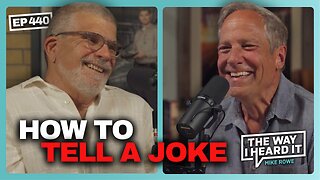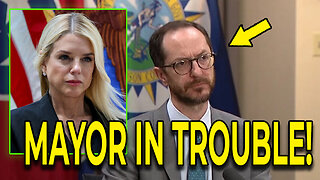Premium Only Content

Old Hollywood Bloopers (1946)
The cinema of the United States, consisting mainly of major film studios (also known metonymously as Hollywood) along with some independent films, has had a large effect on the global film industry since the early 20th century. The dominant style of American cinema is classical Hollywood cinema, which developed from 1910 to 1969 and is still typical of most films made there to this day. While Frenchmen Auguste and Louis Lumière are generally credited with the birth of modern cinema,[5] American cinema soon came to be a dominant force in the emerging industry. As of 2017, it produced the third-largest number of films of any national cinema, after India and China, with more than 600 English-language films released on average every year.[6] While the national cinemas of the United Kingdom, Canada, Australia, and New Zealand also produce films in the same language, they are not part of the Hollywood system. Because of this, Hollywood has also been considered a transnational cinema,[7] and has produced multiple language versions of some titles, often in Spanish or French. Contemporary Hollywood often outsources production to Canada, Australia, and New Zealand.
Hollywood is considered to be the oldest film industry, in the sense of being the place where the earliest film studios and production companies emerged. It is the birthplace of various genres of cinema—among them comedy, drama, action, the musical, romance, horror, science fiction, and the war epic—and has set the example for other national film industries.
During 1878, Eadweard Muybridge demonstrated the power of photography to capture motion. In 1894, the world's first commercial motion-picture exhibition was given in New York City, using Thomas Edison's kinetoscope. In the following decades, production of silent film greatly expanded, studios formed and migrated to California, and films and the stories they told became much longer. The United States produced the world's first sync-sound musical film, The Jazz Singer, in 1927,[8] and was at the forefront of sound-film development in the following decades. Since the early 20th century, the U.S. film industry has primarily been based in and around the thirty-mile zone centered in the Hollywood neighborhood of Los Angeles County, California. Director D.W. Griffith was central to the development of a film grammar. Orson Welles's Citizen Kane (1941) is frequently cited in critics' polls as the greatest film of all time.[9]
The major film studios of Hollywood are the primary source of the most commercially successful and most ticket-selling movies in the world.[10][11] Many of Hollywood's highest-grossing movies have generated more box-office revenue and ticket sales outside the United States than films made elsewhere. The United States is a leading pioneer in motion picture engineering and technology.
History
Main article: History of cinema in the United States
1894–1907: Origins and Fort Lee
See also: Silent film
Justus D. Barnes as outlaw leader Bronco Billy Anderson in The Great Train Robbery (1903), the first western.
The first recorded instance of photographs capturing and reproducing motion was a series of photographs of a running horse by Eadweard Muybridge, which he took in Palo Alto, California, using a set of still cameras placed in a row. Muybridge's accomplishment led inventors everywhere to attempt to make similar devices. In the United States, Thomas Edison was among the first to produce such a device, the kinetoscope.[citation needed]
Harold Lloyd in the clock scene from Safety Last! (1923)
The history of cinema in the United States can trace its roots to the East Coast where, at one time, Fort Lee, New Jersey, was the motion-picture capital of America. The industry got its start at the end of the 19th century with the construction of Thomas Edison's "Black Maria", the first motion-picture studio in West Orange, New Jersey. The cities and towns on the Hudson River and Hudson Palisades offered land at costs considerably less than New York City across the river and benefited greatly as a result of the phenomenal growth of the film industry at the turn of the 20th century.[12] [13][14]
The industry began attracting both capital and an innovative workforce. In 1907, when the Kalem Company began using Fort Lee as a location for filming in the area, other filmmakers quickly followed. In 1909, a forerunner of Universal Studios, the Champion Film Company, built the first studio.[15] Others quickly followed and either built new studios or leased facilities in Fort Lee. In the 1910s and 1920s, film companies such as the Independent Moving Pictures Company, Peerless Studios, The Solax Company, Éclair Studios, Goldwyn Picture Corporation, American Méliès (Star Films), World Film Company, Biograph Studios, Fox Film Corporation, Pathé Frères, Metro Pictures Corporation, Victor Film Company, and Selznick Pictures Corporation were all making pictures in Fort Lee. Such notables as Mary Pickford got their start at Biograph Studios.[16][17][18]
In New York, the Kaufman Astoria Studios in Queens, which was built during the silent film era, was used by the Marx Brothers and W.C. Fields. The Edison Studios were located in the Bronx. Chelsea, Manhattan, was also frequently used. Other Eastern cities, most notably Chicago and Cleveland, also served as early centers for film production.[19][20] In the West, California was already quickly emerging as a major film production center. In Colorado, Denver was home to the Art-O-Graf film company, and Walt Disney's early Laugh-O-Gram animation studio was based in Kansas City, Missouri. Picture City, Florida, was a planned site for a movie picture production center in the 1920s, but due to the 1928 Okeechobee hurricane, the idea collapsed and Picture City returned to its original name of Hobe Sound. An attempt to establish a film production center in Detroit also proved unsuccessful.[21]
The film patents wars of the early 20th century helped facilitate the spread of film companies to other parts of the US, outside New York. Many filmmakers worked with equipment for which they did not own the rights to use. Therefore, filming in New York could be dangerous as it was close to Edison's company headquarters, and close to the agents who the company set out to seize cameras. By 1912, most major film companies had set up production facilities in Southern California near or in Los Angeles because of the region's favorable year-round weather.[22]
1907–1927: Rise of Hollywood
"History of Hollywood" redirects here. For the history of the Los Angeles neighborhood, see Hollywood, Los Angeles § History.
Laurel and Hardy with Lupe Vélez in Hollywood Party (1934)
The 1908 Selig Polyscope Company production of The Count of Monte Cristo directed by Francis Boggs and starring Hobart Bosworth was claimed as the first to have been filmed in Los Angeles, in 1907, with a plaque being unveiled by the city in 1957 at Dearden's flagship store on the corner of Main Street and 7th Street, to mark the filming on the site when it had been a Chinese laundry.[23] Bosworth's widow suggested the city had got the date and location wrong, and that the film was actually shot in nearby Venice, which at the time was an independent city.[24] Boggs' In the Sultan's Power for Selig Polyscope, also starring Bosworth, is considered the first film shot entirely in Los Angeles, with shooting at 7th and Olive Streets in 1909.[25][24]
In early 1910, director D. W. Griffith was sent by the Biograph Company to the west coast with his acting troupe, consisting of actors Blanche Sweet, Lillian Gish, Mary Pickford, Lionel Barrymore and others. They started filming on a vacant lot near Georgia Street in downtown Los Angeles. While there, the company decided to explore new territories, traveling several miles north to Hollywood, a little village that was friendly and enjoyed the movie company filming there. Griffith then filmed the first movie ever shot in Hollywood, In Old California, a Biograph melodrama about California in the 19th century, when it belonged to Mexico. Griffith stayed there for months and made several films before returning to New York. Also in 1910, Selig Polyscope of Chicago established the first film studio in the Los Angeles area in Edendale[23] and the first studio in Hollywood opened in 1912.[26]: 447 After hearing about Griffith's success in Hollywood, in 1913, many movie-makers headed west to avoid the fees imposed by Thomas Edison, who owned patents on the movie-making process.[27] Nestor Studios of Bayonne, New Jersey, built the first studio in the Hollywood neighborhood in 1911.[dubious – discuss] Nestor Studios, owned by David and William Horsley, later merged with Universal Studios; and William Horsley's other company, Hollywood Film Laboratory, is now the oldest existing company in Hollywood, now called the Hollywood Digital Laboratory. California's more hospitable and cost-effective climate led to the eventual shift of virtually all filmmaking to the West Coast by the 1930s. At the time, Thomas Edison owned almost all the patents relevant to motion picture production and movie producers on the East Coast acting independently of Edison's Motion Picture Patents Company were often sued or enjoined by Edison and his agents while movie makers working on the West Coast could work independently of Edison's control.[28]
The Hollywood Walk of Fame on Hollywood Boulevard
In Los Angeles, the studios and Hollywood grew. Before World War I, films were made in several American cities, but filmmakers tended to gravitate towards southern California as the industry developed. They were attracted by the warm climate and reliable sunlight, which made it possible to film their films outdoors year-round and by the varied scenery that was available.[citation needed] War damage contributed to the decline of the then-dominant European film industry, in favor of the United States, where infrastructure was still intact.[29] The stronger early public health response to the 1918 flu epidemic by Los Angeles[30] compared to other American cities reduced the number of cases there and resulted in a faster recovery, contributing to the increasing dominance of Hollywood over New York City.[29] During the pandemic, public health officials temporarily closed movie theaters in some jurisdictions, large studios suspended production for weeks at a time, and some actors came down with the flu. This caused major financial losses and severe difficulties for small studios, but the industry as a whole more than recovered during the Roaring Twenties.[31]
There are several starting points for cinema (particularly American cinema), but it was Griffith's controversial 1915 epic The Birth of a Nation that pioneered the worldwide filming vocabulary that still dominates celluloid to this day.[citation needed]
In the early 20th century, when the medium was new, many Jewish immigrants found employment in the US film industry. They were able to make their mark in a brand-new business: the exhibition of short films in storefront theaters called nickelodeons, after their admission price of a nickel (five cents). Within a few years, ambitious men like Samuel Goldwyn, William Fox, Carl Laemmle, Adolph Zukor, Louis B. Mayer, and the Warner Brothers (Harry, Albert, Samuel, and Jack) had switched to the production side of the business. Soon they were the heads of a new kind of enterprise: the movie studio. The US had at least two female directors, producers and studio heads in these early years: Lois Weber and French-born Alice Guy-Blaché. They also set the stage for the industry's internationalism; the industry is often accused of Amerocentric provincialism.
Other moviemakers arrived from Europe after World War I: directors like Ernst Lubitsch, Alfred Hitchcock, Fritz Lang and Jean Renoir; and actors like Rudolph Valentino, Marlene Dietrich, Ronald Colman, and Charles Boyer. They joined a homegrown supply of actors—lured west from the New York City stage after the introduction of sound films—to form one of the 20th century's most remarkable growth industries. At motion pictures' height of popularity in the mid-1940s, the studios were cranking out a total of about 400 movies a year, seen by an audience of 90 million Americans per week.[32]
Sound also became widely used in Hollywood in the late 1920s.[33] After The Jazz Singer, the first film with synchronized voices was successfully released as a Vitaphone talkie in 1927, Hollywood film companies would respond to Warner Bros. and begin to use Vitaphone sound—which Warner Bros. owned until 1928—in future films. By May 1928, Electrical Research Product Incorporated (ERPI), a subsidiary of the Western Electric company, gained a monopoly over film sound distribution.[32]
A side effect of the "talkies" was that many actors who had made their careers in silent films suddenly found themselves out of work, as they often had bad voices or could not remember their lines. Meanwhile, in 1922, US politician Will H. Hays left politics and formed the movie studio boss organization known as the Motion Picture Producers and Distributors of America (MPPDA).[34] The organization became the Motion Picture Association of America after Hays retired in 1945.
In the early times of talkies, American studios found that their sound productions were rejected in foreign-language markets and even among speakers of other dialects of English. The synchronization technology was still too primitive for dubbing. One of the solutions was creating parallel foreign-language versions of Hollywood films. Around 1930, the American companies[which?] opened a studio in Joinville-le-Pont, France, where the same sets and wardrobe and even mass scenes were used for different time-sharing crews.
Also, foreign unemployed actors, playwrights, and winners of photogenia contests were chosen and brought to Hollywood, where they shot parallel versions of the English-language films. These parallel versions had a lower budget, were shot at night and were directed by second-line American directors who did not speak the foreign language. The Spanish-language crews included people like Luis Buñuel, Enrique Jardiel Poncela, Xavier Cugat, and Edgar Neville. The productions were not very successful in their intended markets, due to the following reasons:
Brown Derby, an icon that became synonymous with the Golden Age of Hollywood.
The lower budgets were apparent.
Many theater actors had no previous experience in cinema.
The original movies were often second-rate themselves since studios expected that the top productions would sell by themselves.
The mix of foreign accents (Castilian, Mexican, and Chilean for example in the Spanish case) was odd for the audiences.
Some markets lacked sound-equipped theaters.
In spite of this, some productions like the Spanish version of Dracula compare favorably with the original. By the mid-1930s, synchronization had advanced enough for dubbing to become usual.
-
 13:54
13:54
The Film Archives
2 years agoOld Hollywood Bloopers (1942)
688 -
 58:49
58:49
Tactical Advisor
2 hours agoUnboxing Tacpack/New 1854 Lever Action | Vault Room Live Stream 029
65K5 -
 LIVE
LIVE
Mossy
1 hour ago🔥RumbleCraftSMP🔥sesh time tap in🔥DUCKY IS ON??🔥#RumbleTakeover🔥
205 watching -
 1:14:49
1:14:49
Mike Rowe
19 hours agoDavid Mamet Pulls No Punches When It Comes To Hollywood & Politics | #440 | The Way I Heard It
37.1K24 -
 LIVE
LIVE
Beyond_Bitz
3 days agoMetal Gear Solid 2 - Part 4 - Finale
141 watching -
 LIVE
LIVE
ttvglamourx
3 hours ago $1.85 earnedPLAYING WITH VIEWERS !DISCORD
183 watching -
 15:19
15:19
T-SPLY
17 hours agoMayor Busted: Nashville Mayor Not Concerned Over Leaking Federal Agents Information!
25.8K81 -
 14:05
14:05
Mrgunsngear
4 hours ago $2.08 earnedHolosun 507 Comp Review: The Best Pistol Optic?
18.3K7 -
 4:15:39
4:15:39
MDGgamin
5 hours ago🔴LIVE - Wake Up Stream Repeat!! - Variety of Games & Chatting - #RumbleTakeover
11.7K -
 LIVE
LIVE
Major League Fishing
3 days agoLIVE Tackle Warehouse Invitationals, Stop 5, Day 2
115 watching